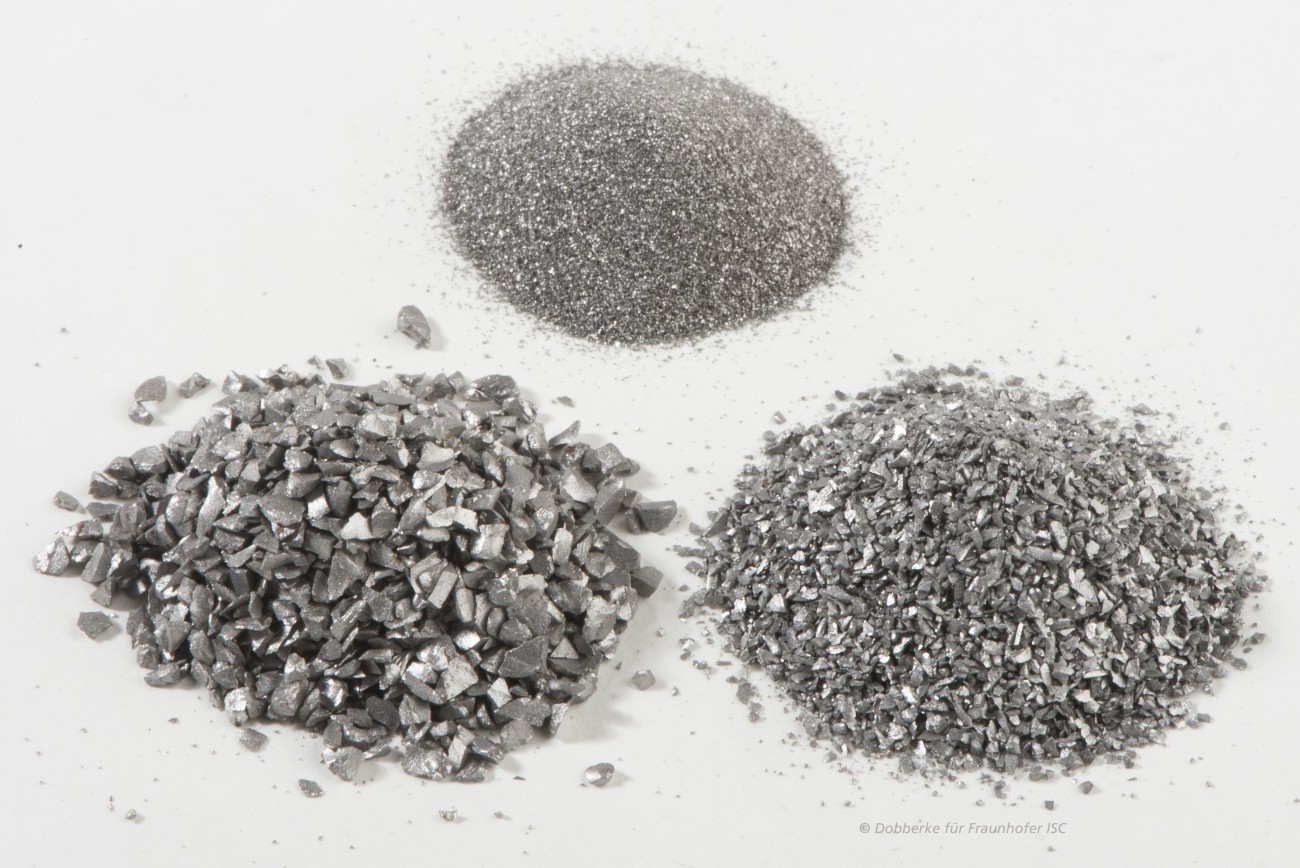Magnetic refrigeration is considered as more efficient and environmental friendly alternative cooling technology [1], [2]. Magnetocaloric materials are classified according to the order of phase transition that they undergo: either first- (FOPT) or second-order (SOPT) type phase transitions. FOPT materials have the advantages of exhibiting large magnetic entropy change and adiabatic temperature change but are accompanied by thermal hysteresis, field rate dependent behavior and decreased cyclic performance compared to quasi-static single shot characterization as a function of field or temperature [3]. Conversely, SOPT materials do not suffer from thermal hysteresis but their magnetocaloric responses are usually smaller as compared to most FOPT materials operating within the same temperature range. Therefore, current goal of magnetocalorics is to combine the best of both types of materials: large response without hysteresis and a tradeoff between static and cyclic performance [4]. The search for such materials bring forth the intermediate point of FOPT converting to SOPT, which is termed the critical point. LaFeSi [5, 6] and MnFePSi-type [7] alloy series are examples exhibiting a gradual change from FOPT to SOPT.
La(Fe,Si)13-based intermetallic compounds with field-induced first-order magnetic phase transition, together with Gd, Fe2P, and Heusler alloys, belong to the magnetocaloric materials considered as promising for use in active magnetic refrigerators (AMR) [8], [9].
Over more than a decade our group has developed extensive experience in the synthesis of extremely phase pure La(Fe,Si)13 based alloys. Moreover we have focused our research on the synthesis of materials with optimal magnetocaloric properties (transition temperature, magnetization, hysteresis width etc.) e.g. by substitution on both, Fe and La sites with transition metals (Ni, Cr, Mn, etc.) [10, 11] and light rare earth elements (Ce, Pr, Nd etc), [12] respectively.
By modulating the magnetic environment of the Fe atoms, the ferromagnetic state can be stabilized either by elemental substitution of Fe (by Co, Mn, Si, etc.) or by interstitial insertion of small light atoms such as C, N, B and H; hence, Ttr can be changed from 190 K up to room temperature and above (340 K) [13]. The hydrogenation of La(Fe,Si)13 is the most efficient method of bringing Ttr near room temperature as the large MCE is retained. The long-term stability of such partial hydrogenated compounds is not guaranteed, as has been reported recently [14]. Therefore, a quaternary compound with Mn is preferentially used to adjust the Ttr of a fully hydrogenated material. Comparable with Si and Co, with increasing Mn content, the type of the magnetic transition is shifted gradually from first to second order and the MCE decreases.
Hydrogenated La(Fe,Mn,Si)13 alloys have high adiabatic temperature change (ΔTad), high magnetic entropy change (ΔSm), and tunable over wide range transition temperature (Ttr). Beside their excellent magnetocaloric properties, these alloys have poor mechanical and chemical stability [15], [16]. Moreover, during the hydrogenation process, the interstitial H atom can cause the decrepitation of the La(Fe,Mn,Si)13 alloy into a powder [15–17], and the La(Fe,Mn,Si)13Hx powder needs additional treatment in order to obtain better machinability and corrosion protection. One simple but efficient method is the use of polymer adhesive for the production of polymer-bonded magnetocaloric material [17–21]. However, the polymer adhesives usually have very low thermal conductivity, and their mechanical properties are sensitive to fatigue and aging effects. As recently reported in [22, 23], this can be avoided by using a metal instead of a polymer as a binder.
All alloys and composite materials are carefully studied and characterized in our laboratories, where beside the standard equipment for structural (SEM, EDX, Kerr) and magnetic characterization (LakeShore VSM, QD-PPMS14, QD-MPMS3), also unique commercial (Ultrasonic option, Razorbill CS100) and in-house build equipment is available (dTad, simultaneous measurements option) [24]. Various sophisticated experimental equipment is accessible in the laboratories of our collaboration partners, e.g. temperature and field dependent XRD [25, 26], Mössbauer spectroscopy, EXAF and XSANES etc [27].
The obtained data is stored in our “library of magnetocaloric material” [28]. The information about the magnetocaloric properties of the various materials is further used for the development of theoretical models [3, 24, 29, 30], but also for the simulation of different magnetocaloric cycles, regenerator geometries etc. and put into praxis by building magnetocaloric demonstrators [31]; the latter resulting into our spin-off company Magnotherm.
[1] Isaac M. et al, “Modeling global residential sector energy demand for heating and air conditioning in the context of climate change,” Energy Policy, vol. 37, no. 2, pp. 507–521, 2009, DOI: 10.1016/j.enpol.2008.09.051
[2] Gauß R. et al, “The resource basis of magnetic refrigeration,” J. Ind. Ecol., pp. 1–10, 2016, DOI: 10.1111/jiec.12488
[3] Law J. Y. et al. “A quantitative criterion for determiningthe order of magnetic phase transitionsusing the magnetocaloric effect“, Nature Commun. 9, 2680 (2018), DOI: 10.1038/s41467-018-05111-w
[4] Franco, V. et al. “Magnetocaloric effect: from materials research to refrigerationdevices” Prog. Mater. Sci. 93, 112–232 (2018), DOI: 10.1016/j.pmatsci.2017.10.005
[5] Gutfleisch, O. et al “Large magnetocaloric effect in melt-spun LaFe13−xSix” J. Appl. Phys.97, 10M305 (2005) DOI: 10.1063/1.1847871
[6] Liu, J. et al. “Exploring La(Fe,Si)13-based magnetic refrigerants towards application” Scr. Mater.67, 584–589 (2012), DOI: 10.1016/j.scriptamat.2012.05.039
[7] Boeije, M. F. J. et al. “Mixed magnetism in magnetocaloric materials with first-order and second-order magnetoelastic transitions” J. Phys. D. Appl. Phys. 50, 8 (2017), DOI: 10.1088/1361-6463/aa5db9
[8] Rühlich I. et al “Investigations on regenerative heat exchangers,” in Cryocoolers, vol. 10. 2002, pp. 265–274, DOI: 10.1007/0-306-47090-X_31
[9] Gutfleisch, O. et al “Magnetic materials and devices for the 21st century: Stronger, lighter, and more energy efficient,” Adv. Mater., vol. 23, no. 7, pp. 821–842, 2011, DOI: 10.1002/adma.201002180
[10] Moreno-Ramírez, Luis M. et al. The role of Ni in modifying the order of the phase transition of La(Fe,Ni,Si)13 Acta Mater., 160, pp. 137-146. (2018) DOI: 10.1016/j.actamat.2018.08.054
[11] Moreno-Ramírez, L. M. et al. “Tunable first order transition in La(Fe,Cr,Si)13 compounds: retaining magnetocaloric response despite a magnetic moment reduction”, Acta Mater, 175, pp. 406-414. (2019), DOI: 10.1016/j.actamat.2019.06.022
[12] Amin D. et al. “The impact of Pr and Nd substitution on structure, hysteresis and magnetocaloric properties of La1−x(Pr,Nd)xFe11.6Si1.4” J. Phys. D: Appl. Phys. 54 225001 (2021), DOI: 10.1088/1361-6463/abea3c
[13] Gutfleisch, O. Et al. „Mastering hysteresis in magnetocaloric materials“ Philosophical Transactions of the Royal Society A: Mathematical, Physical and Engineering Sciences, 374 (2074), p. 20150308, (2016), DOI: 10.1098/rsta.2015.0308
[14] Krautz M, et al. “Reversible solid-state hydrogen-pump driven by magnetostructural transformation in the prototype system La(Fe,Si)13Hy” J. Appl. Phys. 112, 083918, (2012), DOI: 10.1063/1.4759438
[15] Liu J. et al., “Exploring La(Fe,Si)13-based magnetic refrigerants towards application,” Scripta Mater., vol. 67, no. 6, pp. 584–589, 2012, DOI: 10.1016/j.scriptamat.2012.05.039
[16] Krautz M. et al., “Systematic investigation of Mn substituted La(Fe,Si)13 alloys and their hydrides for room-temperature magnetocaloric application,” J. Alloys Compounds, vol. 598, pp. 27–32, Jun. 2014, DOI: 10.1016/j.jallcom.2014.02.015
[17] Skokov K. P. et al., “Heat exchangers made of polymer-bonded La(Fe,Si)13 ,” J. Appl. Phys., vol. 115, no. 17, p. 17A941, 2014. 2502907, DOI: 10.1063/1.4868707
[18] Mayer C. et al. “Towards the large scale production of (La1−zCez)(Fe1−x−yMnySix)13Hn products for room temperature refrigeration,” Phys. Status Solidi C, vol. 11, nos. 5–6, pp. 1059–1063, 2014, DOI: 10.1002/pssc.201300650
[19] Pulko B. et al., “Epoxy-bonded La–Fe–Co–Si magnetocaloric plates,” J. Magn. Magn. Mater., vol. 375, pp. 65–73, Feb. 2015, DOI: 10.1016/j.jmmm.2014.08.074
[20] Radulov I. A., et al. “On the preparation of La(Fe,Mn,Si)13Hx polymer composites with optimized magnetocaloric properties,” J. Magn. Magn. Mater., vol. 396, pp. 228–236, Dec. 2015, DOI: 10.1016/j.jmmm.2015.08.044
[21] Radulov I. A. et al., “Polymer-bonded La(Fe,Mn,Si)13Hx plates for heat exchangers,” IEEE Trans. Magn., vol. 51, no. 11, Nov. 2015, Art. no. 2501204, DOI: 10.1109/TMAG.2015.2435051
[22] Radulov I. A. et al., “Production and properties of metal-bonded La(Fe,Mn,Si)13Hx composite material,” Acta Mater., vol. 127, p. 389, (2017), DOI: 10.1016/j.actamat.2017.01.054
[23] Radulov I. A. et al., “Heat Exchangers From Metal-Bonded La(Fe,Mn,Si)13Hx powder” Acta Mater., vol. 127, p. 389, (2017) DOI: 10.1109/TMAG.2017.2698022
[24] Karpenkov D. Yu., et al. „Pressure Dependence of Magnetic Properties in La(Fe,Si)13: Multistimulus Responsiveness of Caloric Effects by Modeling and Experiment“ Phys Rev Appl., 13 (3), (2020), DOI: 10.1103/PhysRevApplied.13.034014
[25] Faske, T. et al. “X-ray diffractometer for the investigation of temperature- and magnetic field-induced structural phase transitions” J. Appl. Cryst. 51, 761-767 (2018) DOI: 10.1107/S1600576718004892
[26] Faske, T. et al. „Direct observation of paramagnetic spin fluctuations in LaFe13−xSix“ Journal of Physics: Condensed Matter, 32 (11), p. 115802, (2019), DOI: 10.1088/1361-648X/ab5a99
[27] Terwey, A. et al. „Influence of hydrogenation on the vibrational density of states of magnetocaloric LaFe11.4Si1.6H1.6“, Phys Rev B, (6), pp. 064415, (2020), DOI: 10.1103/PhysRevB.101.064415
[28] Gottschall, T. et al. “Making a Cool Choice: The Materials Library of Magnetic Refrigeration”, Advanced Energy Materials, 9 (34), p. 1901322, (2019), DOI: 10.1002/aenm.201901322
[29] Moreno-Ramírez, L. M. et al. Combined kinetic and Bean–Rodbell approach for describing field-induced transitions in LaFe11.6Si1.4 alloys. Journal of Physics D: Applied Physics, 54 (13), p. 135003. (2021), DOI: 10.1088/1361-6463/abd583
[30] Karpenkov, D. Yu., et al. „Anomalous Hall effect in La(Fe,Co)13−xSix compounds“ Phys. Rev. B, 100 (9), pp. 094445, (2019), DOI: 10.1103/PhysRevB.100.094445
[31] Benke, D. et al. „Magnetic Refrigeration with Recycled Permanent Magnets and Free Rare-Earth Magnetocaloric La–Fe–Si“, Energy Technology, 8 (7), p. 1901025, (2020) DOI: 10.1002/ente.201901025




